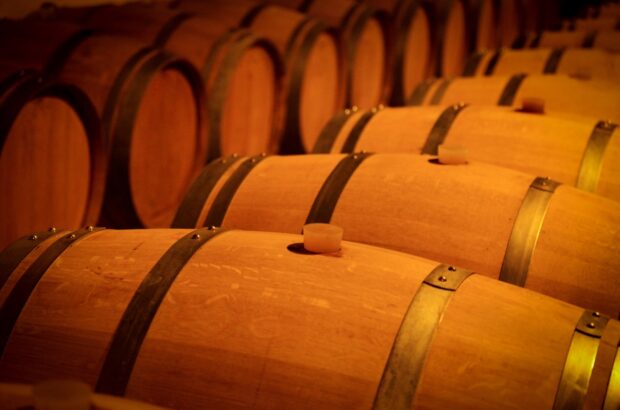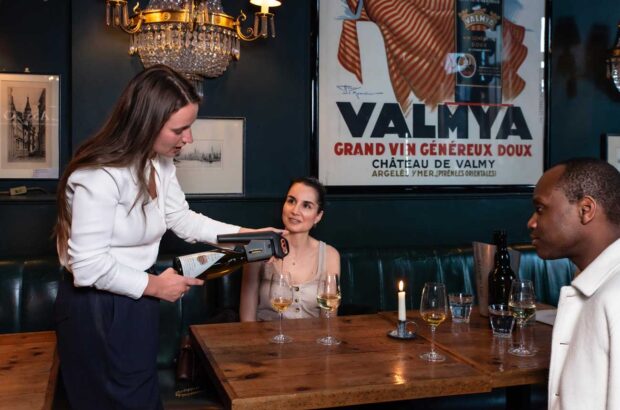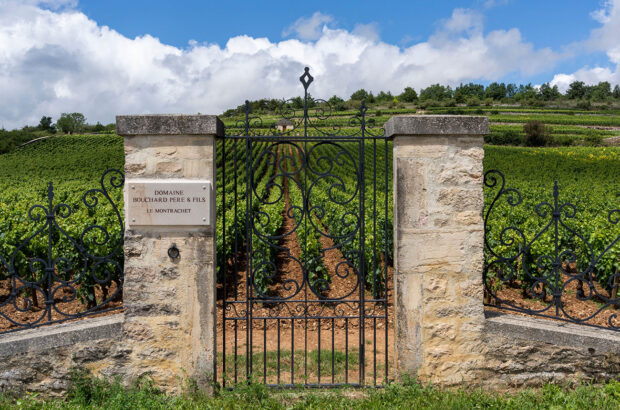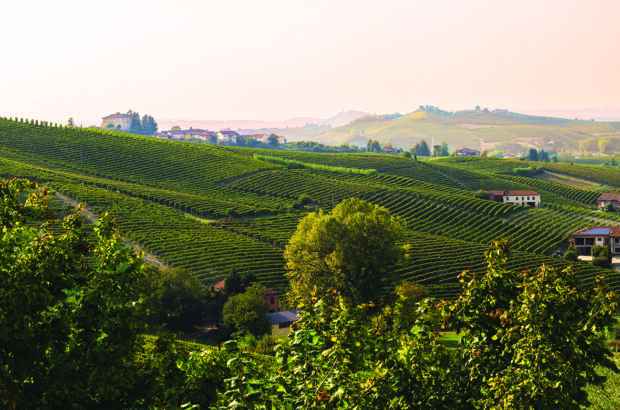Michaela Morris compares several vintages of Antinori’s Tignanello and Solaia, looking at the stylistic evolution of two wines born several years apart in the 1970s but from the same Tuscan property.
One of Italy’s most famed wines, Tignanello is pushing 50. The vineyard was first referenced on a label of Antinori’s 1970 Chianti Classico Riserva and the following year Tignanello eschewed the denomination for the lowly Vino da Tavola designation. Its counterpart, Solaia was born soon afterward in 1978.
Both wines have gone through an evolution. In the early years, their blends modified gradually. Tignanello eventually landed at 80-85% Sangiovese, supported by Cabernet Sauvignon and Cabernet Franc, while Solaia’s 75% Cabernet Sauvignon is rounded out by Sangiovese and Cabernet Franc. With the wines’ identities well-established, Antinori has devoted the last 20 years to fine-tuning the styles.
To explore the transformation of the last two decades, I was invited to Antinori’s California-esque headquarters in San Casciano Val di Pesa, just within the limits of the Chianti Classico region.
{"content":"PHA+Q0VPIGFuZCBjaGllZiB3aW5lbWFrZXIgUmVuem8gQ290YXJlbGxvLCB3aG8gaGFzIHdvcmtlZCB3aXRoIEFudGlub3JpIHNpbmNlIDE5OTAsIGhvbGRzIGZvcnRoLiBIZSBoYXMgYXNzZW1ibGVkIGNvbXBhcmF0aXZlIHZlcnRpY2FscyBpbmNsdWRpbmcgdGhlIHNhbWUgZWlnaHQgdmludGFnZXMgb2YgVGlnbmFuZWxsbyBhbmQgU29sYWlhOiAxOTk3LCAxOTk5LCAyMDAxLCAyMDA1LCAyMDA3LCAyMDEwLCAyMDExIGFuZCAyMDEzLiDigJhUaGVzZSB2aW50YWdlcyByZXByZXNlbnQgb3VyIHN0eWxpc3RpYyBwYXRoIG9mIHRoZSBsYXN0IDIwIHllYXJzLOKAmSBzYXlzIENvdGFyZWxsYS5SZWZpbmluZyB0aGUgdGFubmluIHByb2ZpbGUgaGFzIGJlZW4gdGhlIGxlaXRtb3RpZiBhdCBUZW51dGEgVGlnbmFuZWxsby4gVG8gZXhhbWluZSB0aGUgZXh0ZW50IG9mIHRoaXMgdW5kZXJ0YWtpbmcsIHdlIG1ha2UgdGhlIGZpdmUgbWludXRlIHRyZWsgdG8gdGhpcyBwcm9wZXJ0eSBmcm9tIHdoZXJlIGJvdGggVGlnbmFuZWxsbyBhbmQgU29sYWlhIGhhaWwuPC9wPgo8aHI+CjxoMyBzdHlsZT0idGV4dC1hbGlnbjogY2VudGVyIj48c3Ryb25nPlNjcm9sbCBkb3duIHRvIHNlZSBNaWNoYWVsYSYjODIxNztzIHRhc3Rpbmcgbm90ZXMgYW5kIHNjb3JlcyBmb3IgVGlnbmFuZWxsbyBhbmQgU29sYWlhPC9zdHJvbmc+PC9oMz4KPGhyPgo8aDI+VGhlIHRlcnJvaXI8L2gyPgo8cD5FdmVuIGluIEZlYnJ1YXJ5LCB0aGUgbGF0ZSBhZnRlcm5vb24gc3VuIHNoaW5lcyBsaWtlIGEgc3BvdGxpZ2h0IG9uIHRoZSBhZGphY2VudCBwYXJjZWxzIG9mIDU3aGEgYW5kIDIwaGEgcmVzcGVjdGl2ZWx5LiBXaGlsZSBUaWduYW5lbGxvIGlzIHBvc2l0aW9uZWQgc291dGggdG8gc291dGh3ZXN0IHZlcnN1cyBTb2xhaWEmIzgyMTc7cyBzb3V0aCB0byBzb3V0aGVhc3QgZXhwb3N1cmUsIHRoZSB0d28gYm9hc3QgZXNzZW50aWFsbHkgdGhlIHNhbWUgdGVycm9pci4gVGhlIHN0b255IHNvaWwgaXMgcHJlZG9taW5hbnRseSBnYWxlc3RybyBhbmQgYWxiYXJlc2UgYW5kIHRoZSB2aW5lcyBzaXQgb24gc3RlZXAsIHdlbGwtZHJhaW5lZCBzbG9wZXMgYmV0d2VlbiAzNTAtNDAwIG1ldHJlcyBhYm92ZSBzZWEgbGV2ZWwgaW4gdGhpcyB3aW5keSBjb3JuZXIgb2YgdGhlIENoaWFudGkgQ2xhc3NpY28gem9uZS48L3A+CjxwPjxkaXYgY2xhc3M9ImFkLWNvbnRhaW5lciBhZC1jb250YWluZXItLW1vYmlsZSI+PGRpdiBpZD0icG9zdC1pbmxpbmUtMiIgY2xhc3M9ImlwYy1hZHZlcnQiPjwvZGl2PjwvZGl2PjwvcD4KPHA+SW4gMTk5NywgQW50aW5vcmkgYmVnYW4gYSBjb21wbGV0ZSByZXBsYW50aW5nIG9mIHRoZSB2aW5leWFyZHMsIHdoaWNoIGxhc3RlZCB1bnRpbCAyMDA3LiDigJhJdCB3YXMgZXNzZW50aWFsbHkgYSBtYXNzYWwgc2VsZWN0aW9uIG9mIHRoZSBiZXN0IHZpbmVzLOKAmSBzYXlzIENvdGFyZWxsYS4gVGhleSBhbHNvIGludHJvZHVjZWQgcHVsdmVyaXNlZCBhbGJhcmVzZSBzdG9uZXMgdW5kZXJuZWF0aCB0aGUgdmluZSByb3dzLiBUaGlzIHdoaXRlIGxpbWVzdG9uZSBpbmNyZWFzZXMgc29sYXIgcmFkaWF0aW9uIGFuZCBoYXMgYmVlbiBwYXJ0aWN1bGFybHkgZWZmZWN0aXZlIGZvciBTYW5naW92ZXNlLiDigJhUaGUgZ3JhcGVzIHJpcGVuIHNvb25lciBhbmQgbW9yZSBldmVubHkgd2l0aCBzdWdhciBhbmQgcGhlbm9saWMgcmlwZW5lc3MgYXQgdGhlIHNhbWUgdGltZSzigJkgZXhwbGFpbnMgU3RlZmFubyBDYXJwYW5ldG8gd2hvIGhhcyBiZWVuIHRoZSBtYW5hZ2luZyBkaXJlY3RvciBhdCBUZW51dGEgVGlnbmFuZWxsbyBzaW5jZSAyMDA4LiBXaGlsZSBTYW5naW92ZXNlIHVzZWQgdG8gYmUgcGlja2VkIGFmdGVyIHRoZSBDYWJlcm5ldCBTYXV2aWdub24sIHNpbmNlIHRoZSBlYXJseSAyMDAwcyBpdCB0ZW5kcyB0byBiZSB0aGUgb3RoZXIgd2F5IHJvdW5kLjwvcD4KPGgyPlVwZ3JhZGVzPC9oMj4KPHA+VXBvbiBjb21wbGV0aW9uIG9mIHJlcGxhbnRpbmcsIEFudGlub3JpIHRoZW4gc2V0IGFib3V0IHJlbm92YXRpbmfCoCB0aGUgd2luZXJ5LiDigJhVbnRpbCAyMDA1IHdlIHdvcmtlZCBpbiBhIGZhY2lsaXRpZXMgdGhhdCB3YXMgYm9ybiBmb3IgVGlnbmFuZWxsbywgYnV0IGRpZG4mIzgyMTc7dCBoYXZlIHRoZSB0ZWNobm9sb2d5IHRvIGJlc3QgbWFuYWdlIHRoZSBncmFwZXMs4oCZIHN0YXRlcyBDb3RhcmVsbGEuIEl0IHdhcyByZWRlc2lnbmVkIGFjY29yZGluZyB0byB0aGUgc3BlY2lmaWNpdGllcyBvZiB0aGUgdmluZXlhcmQsIHdpdGggc21hbGxlciB0YW5rcyBmb3Igc2VwYXJhdGUgdmluaWZpY2F0aW9ucyBvZiBlYWNoIHBsb3QuPC9wPgo8cD5Cb3RoIHdpbmVzIGFyZSBub3cgZmVybWVudGVkIGluIGNvbmljYWwgd29vZCB2YXRzLiBDYXJwYW5ldG8gZXhwbGFpbnMgdGhhdCB0aGUgc2hhcGUgaGVscHMgYWNoaWV2ZSBhIHNvZnQgeWV0IHRob3JvdWdoIGV4dHJhY3Rpb24gb2Ygc3dlZXQgcmF0aGVyIHRoYW4gZ3JlZW4gdGFubmlucyB3aGlsZSBhbGxvd2luZyBncmFwZSBza2lucyB0byBzdGF5IGluIGNvbnRhY3Qgd2l0aCB0aGUganVpY2UgbG9uZ2VyIGZvciBncmVhdGVyIGNvbXBsZXhpdHkuPC9wPgo8ZGl2IGNsYXNzPSJhZC1jb250YWluZXIgYWQtY29udGFpbmVyLS1tb2JpbGUiPjxkaXYgaWQ9InBvc3QtaW5saW5lLTMiIGNsYXNzPSJpcGMtYWR2ZXJ0Ij48L2Rpdj48L2Rpdj4KPHA+Rm9yIENvdGFyZWxsYSwgZ2VudGxlIGV4dHJhY3Rpb24gaXMga2V5LiDigJhTYW5naW92ZXNlIGNhbiBiZSBlaXRoZXIgdmlicmFudCwgbmVydm91cyBvciBoeXN0ZXJpYyBkZXBlbmRpbmcgb24gaG93IHlvdSBoYW5kbGUgaXQs4oCZIGhlIHNheXMsIHJlZmVycmluZyB0byB0aGUgZ3JhcGUmIzgyMTc7cyBlbGV2YXRlZCBhY2lkaXR5IGFuZCB0YW5uaW5zLiBXaGVuIHdlbGwtbWFuYWdlZCwgdGhlc2UgY2FuIGJlIG9mIHZhbHVlIGdpdmluZyBhbiBpbnRlZ3JhdGVkIHZlcnRpY2FsIHNlbnNhdGlvbi4gSG93ZXZlciwgaWYgbWlzbWFuYWdlZCB0aGUgd2luZSBiZWNvbWVzIGFnZ3Jlc3NpdmUgYW5kIGRpZmZpY3VsdCB0byBkcmluay48L3A+CjxoMj5NYXR1cmF0aW9uPC9oMj4KPHA+RXZlbiB0aGUgYWdlaW5nIG9mIFNhbmdpb3Zlc2UgaGFzIG1vcnBoZWQuIEZvciBUaWduYW5lbGxvLCBBbnRpbm9yaSBpcyBtb3ZpbmcgYXdheSBmcm9tIGFsbCBiYXJyaXF1ZXMgYW5kIGhhcyBpbnRyb2R1Y2VkIHNvbWUgbGFyZ2VyIHRvbm5lYXV4LiBBcHByb3hpbWF0ZWx5IDUwJSBvZiB0aGUgd29vZCBpcyBuZXcsIGJ1dCB0aGUgcHJvdmVuYW5jZSBub3cgaW5jbHVkZXMgSHVuZ2FyaWFuIGFzIHdlbGwgYXMgRnJlbmNoIG9hay4g4oCYQmVjYXVzZSBpdCBpcyBhIG1vcmUgbmV1dHJhbCB3b29kLCBIdW5nYXJpYW4gb2FrIGlzIHZlcnkgYWRhcHRlZCB0byB2YXJpZXRpZXMgd2hpY2ggaGF2ZSBhIHN0cm9uZyB2YXJpZXRhbCBjaGFyYWN0ZXIgbGlrZSBTYW5naW92ZXNlLCBpbXBhcnRpbmcgbGVzcyB2YW5pbGxhIGFuZCBjaG9jb2xhdGUgbm90ZXMs4oCZIGRlc2NyaWJlcyBDYXJwYW5ldG8uPC9wPgo8ZGl2IGNsYXNzPSJhZC1jb250YWluZXIgYWQtY29udGFpbmVyLS1tb2JpbGUiPjxkaXYgaWQ9InBvc3QtaW5saW5lLTQiIGNsYXNzPSJpcGMtYWR2ZXJ0Ij48L2Rpdj48L2Rpdj4KPHA+QXMgZm9yIFNvbGFpYSwgd2hpY2ggaXMgYWdlZCBlbnRpcmVseSBpbiBuZXcgRnJlbmNoIG9haywgQW50aW5vcmkgaXMgbm93IHdvcmtpbmcgZXhjbHVzaXZlbHkgd2l0aCB0aGUgVGFyYW5zYXVkIGFuZCBTZWd1aW4gTW9yZWF1IGNvb3BlcmFnZXMuPC9wPgo8aDI+VGhlIHRhc3Rpbmc8L2gyPgo8cD5CYWNrIGF0IEFudGlub3JpJiM4MjE3O3MgaGVhZHF1YXJ0ZXJzLCB3ZSB3b3JrIG91ciB3YXkgdGhyb3VnaCB0aGUgdHdvIHZlcnRpY2FscyBzZXBhcmF0ZWx5LCBzdGFydGluZyB3aXRoIHRoZSBUaWduYW5lbGxvLiBUaGUgdGFzdGluZyBpcyBvcmdhbmlzZWQgZnJvbSBvbGRlc3QgdG8geW91bmdlc3QgdG8gZm9sbG93IHRoZSBjaHJvbm9sb2dpY2FsIHByb2dyZXNzLjwvcD4KPGRpdiBjbGFzcz0iYWQtY29udGFpbmVyIGFkLWNvbnRhaW5lci0tbW9iaWxlIj48ZGl2IGlkPSJwb3N0LWlubGluZS01IiBjbGFzcz0iaXBjLWFkdmVydCI+PC9kaXY+PC9kaXY+CjxwPuKAmEVhY2ggd2luZSBpcyB0aGUgZXhwcmVzc2lvbiBvZiBhIHNwZWNpZmljIGVyYSzigJkgYXNzZXJ0cyBDb3RhcmVsbGEuIEhlIGRlc2NyaWJlcyB0aGUgc3R5bGlzdGljIHJvdXRlIGFzIHN0YXJ0aW5nIGluIEF1c3RyYWxpYSBpbiB0aGUgMTk5MHMsIHRoZW4gdHJhbnNpdGlvbmluZyB0byBCb3JkZWF1eCwgZm9sbG93ZWQgYnkgQ2FsaWZvcm5pYSwgZW5kaW5nIHVwIGluIEJ1cmd1bmR5LiDigJhTaW5jZSAyMDAxLCB3ZSBoYXZlIHN0cml2ZWQgdG8gbWFrZSBtb3JlIHJlZmluZWQsIHZpYnJhbnQgYW5kIGxlc3MgcG93ZXJmdWwgd2luZXMgdGhhdCBzdGlsbCByZWZlciB0byBwbGFjZSBhbmQsIGFib3ZlIGFsbCwgYXJlIGJhbGFuY2VkIGFuZCBkcmlua2FibGUu4oCZPC9wPgo8cD5JIGhhdmUgYmVlbiBsdWNreSBlbm91Z2ggdG8gdHJ5IG9sZGVyIHZpbnRhZ2VzIG9mIFRpZ25hbmVsbG8gb24gbWFueSBvY2Nhc2lvbnMsIHRob3VnaCBuZXZlciBpbiBhIGZvcm1hdCBzdWNoIGFzIHRoaXMuIFRoZSBsZWFwIGZyb20gMjAwNyB0byAyMDEwIGNsZWFybHkgZGVtb25zdHJhdGVzIHRoZSBpbmNyZWFzZWQgc29waGlzdGljYXRpb24gYW5kIHBvbGlzaCBvZiB0aGUgdGFubmluIHN0cnVjdHVyZS48L3A+CjxwPlRoZSBiaWdnZXN0IHN1cnByaXNlIGluIHRoZSBsaW5ldXAgd2FzIHRoZSBjb29sZXIsIHVuZGVyLXRoZSAtcmFkYXIgMjAwNSwgZXNwZWNpYWxseSBmb3IgZHJpbmtpbmcgbm93LiBUaG91Z2ggc3RpbGwgaW4gbmVlZCBvZiBhZ2UsIDIwMTAgaXMgbGl2aW5nIHVwIHRvIGl0cyByZXB1dGF0aW9uLCBhbmQgMjAxMyBzaG93cyBwbGVudHkgb2YgcHJvbWlzZS48L3A+CjxwPkNvbnZlcnNlbHksIHdoaWxlIGdvb2Qgd2luZXMsIGJvdGggdGhlIGhpZ2hseSByZWdhcmRlZCAyMDAxIGFuZCAyMDA3IHZpbnRhZ2VzIHdlcmUgYSBiaXQgZGlzYXBwb2ludGluZyB3aXRoaW4gdGhlIGNvbnRleHQgb2YgdGhlaXIgaHlwZS4gSW4gdGhlIHdvcmxkIG9mIGNvbGxlY3RpYmxlIHdpbmUsIFRpZ25hbmVsbG8gcmVtYWlucyBhY2Nlc3NpYmx5IHByaWNlZCwgbWFraW5nIHZpbnRhZ2VzIGxpa2UgMjAxMCwgMjAxMyBhbmQgMjAwNSByZWxhdGl2ZWx5IGdyZWF0IHZhbHVlLjwvcD4KPHA+QXMgZm9yIFNvbGFpYSwgbW9zdCBvZiBteSBleHBlcmllbmNlIGlzIHRhc3RpbmcgdGhpcyB3aW5lIGp1c3QgYWZ0ZXIgaXRzIHJlbGVhc2UuIEl0IGlzIGFsd2F5cyBmYXIgdG9vIHlvdW5nLCBuZWVkaW5nIHRpbWUgZm9yIHRoZSBvYWsgdG8gaW50ZWdyYXRlLjwvcD4KPHA+VGhpcyB2ZXJ0aWNhbCBhbHNvIGRlbW9uc3RyYXRlZCB0aGF0IGFmdGVyIDEwLTEyIHllYXJzIG9mIGFnZSwgU29sYWlhIHN0YXJ0cyB0byBleHByZXNzIGl0cyBzaXRlLiBXaGlsZSB0aGVyZSBoYXMgYmVlbiBhIGZpbmVzc2luZyBvZiB0YW5uaW5zIG92ZXIgdGhlIHllYXJzLCBpdCBpcyBsZXNzIG9idmlvdXMgdGhhbiB0aGUgVGlnbmFuZWxsbyBhcyBTb2xhaWEgc2VlbXMgdG8gYmUgYSBtb3JlIGZvcmdpdmluZyB3aW5lLiBJdCBhbHNvIHRlbmRzIHRvIGhhbmRsZSB0aGUgd2FybWVyIHllYXJzIGJldHRlci48L3A+CjxwPkFib3ZlIGFsbCwgd2hhdCBzdG9vZCBvdXQgaXMgdGhlIGNvbnNpc3RlbnQgaGlnaCBxdWFsaXR5LCBjb25maXJtaW5nIFNvbGFpYSYjODIxNztzIHJlcHV0YXRpb24gYXMgYSBjZWxsYXJpbmcgY2xhc3NpYy4gVGhlIDIwMTAgaXMgZXh0cmFvcmRpbmFyeSBpbiB0aGlzIHJlZ2FyZCBidXQgcmVxdWlyZXMgbW9yZSB0aW1lLiBJIHdhcyBzbWl0dGVuIHdpdGggdGhlIDE5OTkgZm9yIGRyaW5raW5nIG5vdy48L3A+CjxwPldoZW4gSSBzaGFyZSBteSBleGNpdGVtZW50IGZvciB0aGUgMTk5OSBTb2xhaWEsIENvdGFyZWxsYSBkb2VzbiYjODIxNzt0IGhlc2l0YXRlLCBwaWNraW5nIHVwIHRoZSBib3R0bGUgdG8gYnJpbmcgYWxvbmcgZm9yIGx1bmNoLiBUcnVseSB3aXRoIGFnZSBhbmQgYXQgdGhlIHRhYmxlIGlzIHRoZSBiZXN0IHdheSB0byBlbmpveSBib3RoIFNvbGFpYSBhbmQgVGlnbmFuZWxsby48L3A+CjxoMj48c3Ryb25nPlRpZ25hbmVsbG8gYW5kIFNvbGFpYSB2aW50YWdlcyBjb21wYXJlZDwvc3Ryb25nPjwvaDI+CjxkaXYgY2xhc3M9ImJyZWFrb3V0IHBhbGV0dGUtYSBwYW5lbCBwYW5lbC1kZWZhdWx0Ij48ZGl2IGNsYXNzPSJwYW5lbC1ib2R5Ij48ZGl2IGNsYXNzPSdicmVha291dC1jb250ZW50Jz48L3A+CjxwPjxzdHJvbmc+MTk5Nzwvc3Ryb25nPjwvcD4KPHA+QXQgdGhlIHRpbWUsIDE5OTcgd2FzIGNvbnNpZGVyZWQgb25lIG9mIHRoZSBiZXN0IHZpbnRhZ2VzIG9mIHRoZSBwcmV2aW91cyA1MCB5ZWFycy4gVGhlIGdyb3dpbmcgc2Vhc29uIHdhcyBwcmVjb2Npb3VzIHRocm91Z2hvdXQgYW5kIGhvdCBzdW5ueSBjb25kaXRpb25zIGNvbnRpbnVlZCByaWdodCB1cCB1bnRpbCBoYXJ2ZXN0LiBDYWJlcm5ldCBTYXV2aWdub24gd2FzIHBpY2tlZCBmaXJzdCBmb3IgYm90aCB3aW5lcy4gVGhpcyB3YXMgdGhlIGxhc3QgdmludGFnZSBiZWZvcmUgaW50ZW5zaXZlIHJlcGxhbnRpbmcgYmVnYW4uIENvbXBhcmluZyB0aGUgdHdvIGF0IGFsbW9zdCAyMCB5ZWFycyBvZiBhZ2UsIHRoZSBUaWduYW5lbGxvIHNlZW1zIHRvIGhhdmUgYWdlZCBtb3JlIGhhcm1vbmlvdXNseSBpbiB0ZXJtcyBvZiBmcnVpdCBhbmQgdGFubmluIGJhbGFuY2UuPC9wPgo8cD48c3Ryb25nPjE5OTk8L3N0cm9uZz48L3A+CjxwPkxlc3MgaHlwZWQsIDE5OTkgd2FzIGEgZnJlc2hlciB5ZWFyLiBJdCB3YXMgYWxzbyB2ZXJ5IHByb2R1Y3RpdmUgcmVxdWlyaW5nIGEgbG90IG9mIGdyYXBlIHRoaW5uaW5nLiBIYXJ2ZXN0IGZvciBDYWJlcm5ldCBTYXV2aWdub24gc3RhcnRlZCBvbiAyNSBTZXB0ZW1iZXIgd2hpbGUgdGhlIFNhbmdpb3Zlc2UgZm9sbG93ZWQgb25lIHdlZWsgbGF0ZXIuIOKAmEl0IHdhcyBhbHdheXMgY29uc2lkZXJlZCBhIGdyZWF0IHZpbnRhZ2UgZm9yIFNvbGFpYSzigJkgc2F5cyBDb3RhcmVsbGEgYXB0bHkgZGVzY3JpYmluZyBpdCBhcyBjb21wYWN0IGFuZCBzYXZvdXJ5IHdoaWxlIHRoZSBUaWduYW5lbGxvIGlzIGxpZ2h0ZXIuPC9wPgo8cD48c3Ryb25nPjIwMDE8L3N0cm9uZz48L3A+CjxwPlRoZSAyMDAxIHZpbnRhZ2Ugd2FzIGFub3RoZXIgaGlnaGx5IHJlZ2FyZGVkIHZpbnRhZ2Ugd2l0aCBjb29sIG5pZ2h0cyBvZmZzZXR0aW5nIGhpZ2ggZGF5IHRpbWUgdGVtcGVyYXR1cmVzLiBIb3dldmVyLCBDb3RhcmVsbGEgYWRtaXRzIHRoYXQgaXQgd2FzIGp1c3QgYSBiaXQgdG9vIGhvdCBhbmQgdGhlIGdyYXBlcyByaXBlbmVkIGEgYml0IHRvbyBmYXN0LiBIZSBhZGRzLCDigJhpbiAyMDAxLCB3ZSB3ZXJlIG1ha2luZyB3aW5lcyB0aGF0IHdlcmUganVzdCBhIGxpdHRsZSB0b28gcG93ZXJmdWwgd2l0aCBtb3JlIHdvb2QsIHN0cnVjdHVyZSBhbmQgZmF0LuKAmSBIZSBjYWxscyBpdCBhbiBpbXBvcnRhbnQgZXhwZXJpbWVudCB0aGF0IGhlbHBlZCBkZXRlcm1pbmUgdGhlIGNoYW5nZSBpbiBkaXJlY3Rpb24gdGhhdCB0aGV5IGhhdmUgdGFrZW4gc2luY2UuPC9wPgo8cD48c3Ryb25nPjIwMDU8L3N0cm9uZz48L3A+CjxwPkp1bmUsIEp1bHkgYW5kIEF1Z3VzdCB3ZXJlIGFsbCByZWxhdGl2ZWx5IGNvb2wgYW5kIHRoZSBsYXR0ZXIgbW9udGggcmF0aGVyIHJhaW55LiBUaGUgbGF0ZSBhbmQgcHJvdHJhY3RlZCBoYXJ2ZXN0IGVuZGVkIHRoZSBzZWNvbmQgd2VlayBvZiBPY3RvYmVyIGFuZCB3YXMgZXNwZWNpYWxseSBjaGFsbGVuZ2luZyBmb3IgU2FuZ2lvdmVzZS4gUHJpb3IgdG8gMjAwNCwgdGhlIGNvbXBvbmVudHMgZm9yIGJvdGggd2luZXMgd2VyZSBhc3NlbWJsZWQgZGlyZWN0bHkgZm9sbG93aW5nIG1hbG9sYWN0aWMgZmVybWVudGF0aW9uLiBUaGlzIG1hcmtzIHRoZSBzZWNvbmQgdmludGFnZSBpbiB3aGljaCBibGVuZGluZyBvY2N1cnJlZCBhZnRlciBiYXJyZWwgYWdlaW5nLCBhbm90aGVyIG1vZGlmaWNhdGlvbiB3aGljaCBoYXMgZ2l2ZW4gZ3JlYXRlciBwcmVjaXNpb24gdG8gdGhlIHdpbmVtYWtpbmcuPC9wPgo8cD48c3Ryb25nPjIwMDc8L3N0cm9uZz48L3A+CjxwPjIwMDcgd2FzIGNvbnNpZGVyZWQgYSBncmVhdCB2aW50YWdlIGluIFR1c2NhbnkuIFRoZSBob3Qgc3VtbWVyIGNvb2xlZCBvZmYgYSBiaXQgaW4gQXVndXN0IHRoZW4gU2VwdGVtYmVyIGFuZCBPY3RvYmVyIGNvbnRpbnVlZCB3aXRoIHdhcm0gc3VubnkgZGF5cyBjb3VudGVyZWQgYnkgY29vbCBuaWdodHMuIEhhcnZlc3Qgd2FzIHNsaWdodGx5IGVhcmx5IHdpdGggcmVzcGVjdCB0byBwcmV2aW91cyB2aW50YWdlcy4gVGhpcyBpcyB0aGUgZmlyc3QgeWVhciBpbiB3aGljaCB0aGUgd2luZXMgYXJlIGNyYWZ0ZWQgZW50aXJlbHkgZnJvbSBuZXcgcGxhbnRpbmdzLiBCYXNlZCBvbiB0aGUgYm90dGxlcyBJIHRyaWVkLCBTb2xhaWEgaXMgYWdlaW5nIGJldHRlciB0aGFuIHRoZSBUSWduYW5lbGxvIGluIDIwMDcuPC9wPgo8cD48c3Ryb25nPjIwMTA8L3N0cm9uZz48L3A+CjxwPkRlc3BpdGUgYmVpbmcgaGlnaGx5IHRvdXRlZCwgdGhlIDIwMTAgZ3Jvd2luZyBzZWFzb24gd2FzIHNvbWV3aGF0IGNoYWxsZW5naW5nLiBJdCB3YXMgZmFpcmx5IGNvb2wgb3ZlcmFsbCB3aXRoIHBlcmlvZHMgb2YgcmFpbiB0aHJvdWdob3V0IHRob3VnaCBzdHJvbmcgd2luZHMgaW4gU2VwdGVtYmVyIGhlbHBlZCBkcnkgdGhlIHZpbmV5YXJkcyBxdWlja2x5LiBXaXRoaW4gdGhlIGNvbnRleHQgb2YgdGhpcyB2ZXJ0aWNhbCwgMjAxMCBpcyB0aGUgZmlyc3QgdmludGFnZSBpbiB3aGljaCBib3RoIHdpbmVzIHdlcmUgbWFkZSBpbiB0aGUgbmV3bHkgcmVub3ZhdGVkIGNlbGxhciBhbmQsIGZvciB0aGUgVGlnbmFuZWxsbywgaXQgcmVwcmVzZW50cyB0aGUgaW50cm9kdWN0aW9uIG9mIEh1bmdhcmlhbiBvYWsgZm9yIGFnZWluZy48L3A+CjxwPjxzdHJvbmc+MjAxMTwvc3Ryb25nPjwvcD4KPHA+VGhlIHN1bW1lciBvZiAyMDExIHdhcyBtYXJrZWQgYnkgYSBzdWRkZW4gaGVhdCB3YXZlIHdoaWNoIGxhc3RlZCBmcm9tIHRoZSBiZWdpbm5pbmcgb2YgQXVndXN0IHRvIG1pZC1TZXB0ZW1iZXIgY2F1c2luZyB0aGUgdmluZXMgdG8gc2h1dCBkb3duIHRlbXBvcmFyaWx5LiBDb3RhcmVsbGEgZXhwbGFpbnMgdGhhdCB0aGV5IGhhZCB0byB3b3JrIG9uIHRoZSBkZWZlbnNpdmUuIEhlIGRlc2NyaWJlcyBUaWduYW5lbGxvIGFzIHNsaWdodGx5IHVuYmFsYW5jZWQgYW5kIFNvbGFpYSBhcyBhIGJpdCBqYW1teS4g4oCYVGhleSBhcmUgZmluZSBhcyB3aW5lcyBidXQgZG9uJiM4MjE3O3QgcmVwcmVzZW50IHRoZSBzZW5zZSBvZiBmaW5lc3NlLOKAmSBoZSBjb250aW51ZXMuIMKg4oCYSG93ZXZlciwgdGhleSBhcmUgdHJ1ZSByZXByZXNlbnRhdGlvbnMgb2YgdGhlIHllYXIu4oCZPC9wPgo8cD48c3Ryb25nPjIwMTM8L3N0cm9uZz48L3A+CjxkaXYgY2xhc3M9ImluamVjdGlvbiI+PC9kaXY+CjxwPlRoZSBzdW1tZXIgb2YgMjAxMyB3YXMgd2FybSBhbmQgZHJ5IHdpdGhvdXQgZXh0cmVtZXMgb2YgaGVhdC4gVGhlIHdhcm0gZGF5cyBjb250aW51ZWQgdGhyb3VnaCBTZXB0ZW1iZXIgYW5kIHRoZSBmaXJzdCBoYWxmIG9mIE9jdG9iZXIgd2l0aCBwcm9ub3VuY2VkIHRlbXBlcmF0dXJlIGRpZmZlcmVuY2VzLiBIYXJ2ZXN0IHdhcyBsYXRlciB0aGFuIHRoZSBwcmV2aW91cyBmZXcgdmludGFnZXMgYmVnaW5uaW5nIHdpdGggdGhlIFNhbmdpb3Zlc2UgZm9yIFRpZ25hbmVsbG8gb24gMjUgU2VwdGVtYmVyIGFuZCBlbmRpbmcgd2l0aCB0aGUgQ2FiZXJuZXQgU2F1dmlnbm9uIGZvciBTb2xhaWEgYmV0d2VlbiA3LTE2IE9jdG9iZXIuIFdpdGggdGhpcyB2aW50YWdlLCB0aGUgZWFybGllc3Qgb2YgdGhlIG5ldyBwbGFudGluZ3MgaGF2ZSByZWFjaGVkIDE1IHllYXJzIG9mIGFnZS48L3A+CjxwPgo8L2Rpdj48ZGl2IGNsYXNzPSdicmVha291dC1idXR0b25zJz48ZGl2IGNsYXNzPSdyb3cnPjwvZGl2PjwvZGl2PjwvZGl2PjwvZGl2Pgo8cD4K"}
Michaela’s tasting notes and scores for Solaia and Tignanello:
{}
{"wineId":"21278","displayCase":"standard","paywall":true}
{"wineId":"21286","displayCase":"standard","paywall":true}
{"wineId":"21277","displayCase":"standard","paywall":true}
{"wineId":"21285","displayCase":"standard","paywall":true}
{"wineId":"21276","displayCase":"standard","paywall":true}
{"wineId":"21284","displayCase":"standard","paywall":true}
{"wineId":"21275","displayCase":"standard","paywall":true}
{"wineId":"21283","displayCase":"standard","paywall":true}
{"wineId":"21274","displayCase":"standard","paywall":true}
{"wineId":"21282","displayCase":"standard","paywall":true}
{"wineId":"21273","displayCase":"standard","paywall":true}
{"wineId":"21281","displayCase":"standard","paywall":true}
{"wineId":"21272","displayCase":"standard","paywall":true}
{"wineId":"21280","displayCase":"standard","paywall":true}
{"wineId":"21271","displayCase":"standard","paywall":true}
{"wineId":"21279","displayCase":"standard","paywall":true}
{}
Other articles like this one, available to Premium members:












